check oil FIAT TALENTO 2020 Owner handbook (in English)
[x] Cancel search | Manufacturer: FIAT, Model Year: 2020, Model line: TALENTO, Model: FIAT TALENTO 2020Pages: 236, PDF Size: 4.86 MB
Page 7 of 236
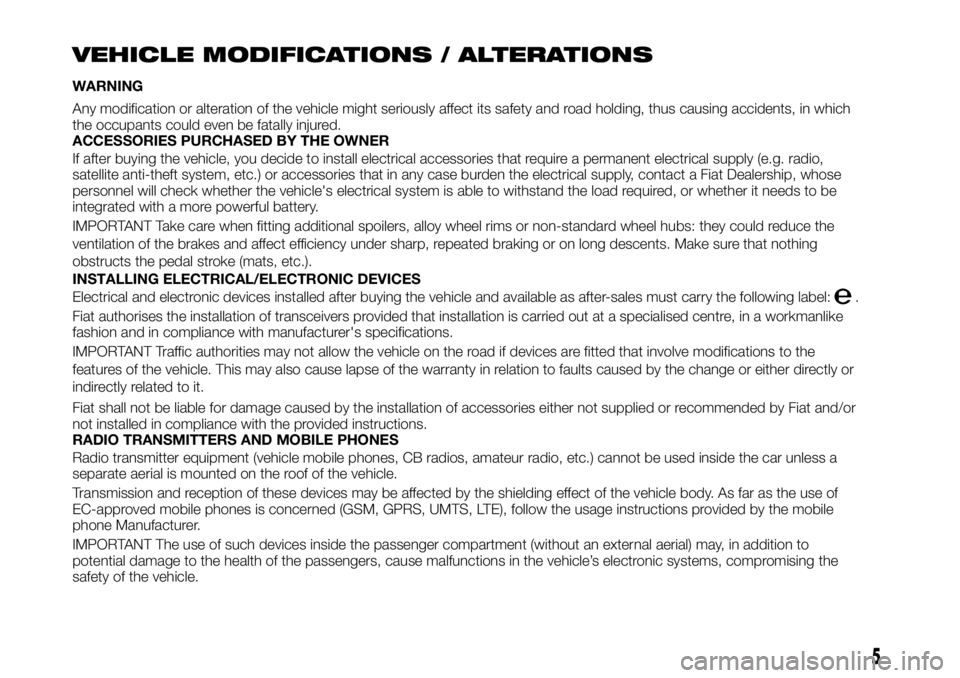
VEHICLE MODIFICATIONS / ALTERATIONS
WARNING
Any modification or alteration of the vehicle might seriously affect its safety and road holding, thus causing accidents, in which
the occupants could even be fatally injured.
ACCESSORIES PURCHASED BY THE OWNER
If after buying the vehicle, you decide to install electrical accessories that require a permanent electrical supply (e.g. radio,
satellite anti-theft system, etc.) or accessories that in any case burden the electrical supply, contact a Fiat Dealership, whose
personnel will check whether the vehicle's electrical system is able to withstand the load required, or whether it needs to be
integrated with a more powerful battery.
IMPORTANT Take care when fitting additional spoilers, alloy wheel rims or non-standard wheel hubs: they could reduce the
ventilation of the brakes and affect efficiency under sharp, repeated braking or on long descents. Make sure that nothing
obstructs the pedal stroke (mats, etc.).
INSTALLING ELECTRICAL/ELECTRONIC DEVICES
Electrical and electronic devices installed after buying the vehicle and available as after-sales must carry the following label:.
Fiat authorises the installation of transceivers provided that installation is carried out at a specialised centre, in a workmanlike
fashion and in compliance with manufacturer's specifications.
IMPORTANT Traffic authorities may not allow the vehicle on the road if devices are fitted that involve modifications to the
features of the vehicle. This may also cause lapse of the warranty in relation to faults caused by the change or either directly or
indirectly related to it.
Fiat shall not be liable for damage caused by the installation of accessories either not supplied or recommended by Fiat and/or
not installed in compliance with the provided instructions.
RADIO TRANSMITTERS AND MOBILE PHONES
Radio transmitter equipment (vehicle mobile phones, CB radios, amateur radio, etc.) cannot be used inside the car unless a
separate aerial is mounted on the roof of the vehicle.
Transmission and reception of these devices may be affected by the shielding effect of the vehicle body. As far as the use of
EC-approved mobile phones is concerned (GSM, GPRS, UMTS, LTE), follow the usage instructions provided by the mobile
phone Manufacturer.
IMPORTANT The use of such devices inside the passenger compartment (without an external aerial) may, in addition to
potential damage to the health of the passengers, cause malfunctions in the vehicle’s electronic systems, compromising the
safety of the vehicle.
5
Page 83 of 236
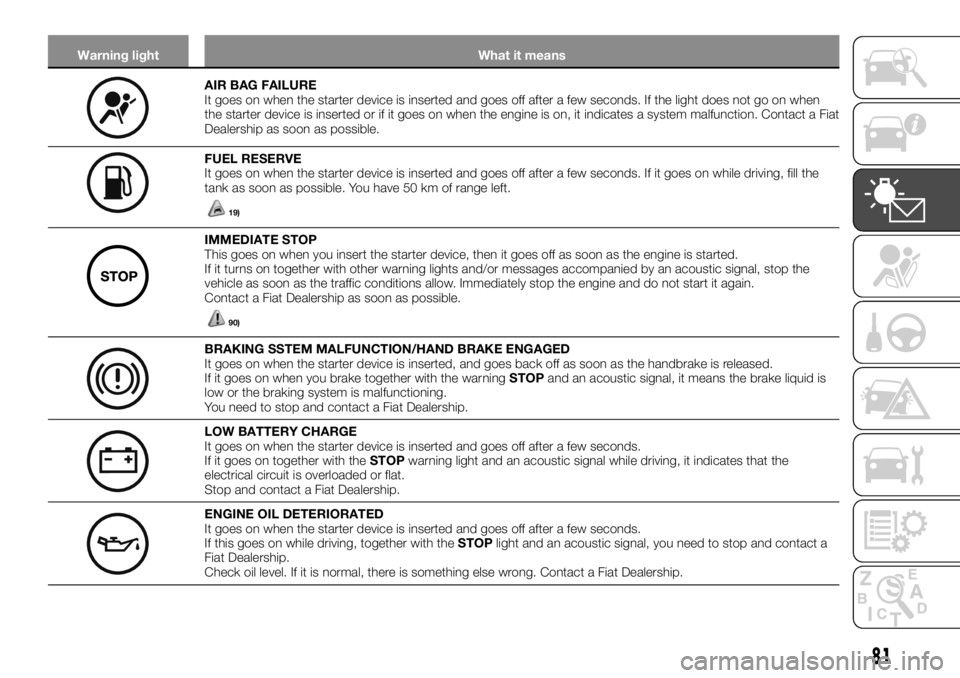
Warning light What it means
AIR BAG FAILURE
It goes on when the starter device is inserted and goes off after a few seconds. If the light does not go on when
the starter device is inserted or if it goes on when the engine is on, it indicates a system malfunction. Contact a Fiat
Dealership as soon as possible.
FUEL RESERVE
It goes on when the starter device is inserted and goes off after a few seconds. If it goes on while driving, fill the
tank as soon as possible. You have 50 km of range left.
19)
IMMEDIATE STOP
This goes on when you insert the starter device, then it goes off as soon as the engine is started.
If it turns on together with other warning lights and/or messages accompanied by an acoustic signal, stop the
vehicle as soon as the traffic conditions allow. Immediately stop the engine and do not start it again.
Contact a Fiat Dealership as soon as possible.
90)
BRAKING SSTEM MALFUNCTION/HAND BRAKE ENGAGED
It goes on when the starter device is inserted, and goes back off as soon as the handbrake is released.
If it goes on when you brake together with the warningSTOPand an acoustic signal, it means the brake liquid is
low or the braking system is malfunctioning.
You need to stop and contact a Fiat Dealership.
LOW BATTERY CHARGE
It goes on when the starter device is inserted and goes off after a few seconds.
If it goes on together with theSTOPwarning light and an acoustic signal while driving, it indicates that the
electrical circuit is overloaded or flat.
Stop and contact a Fiat Dealership.
ENGINE OIL DETERIORATED
It goes on when the starter device is inserted and goes off after a few seconds.
If this goes on while driving, together with theSTOPlight and an acoustic signal, you need to stop and contact a
Fiat Dealership.
Check oil level. If it is normal, there is something else wrong. Contact a Fiat Dealership.
81
Page 166 of 236
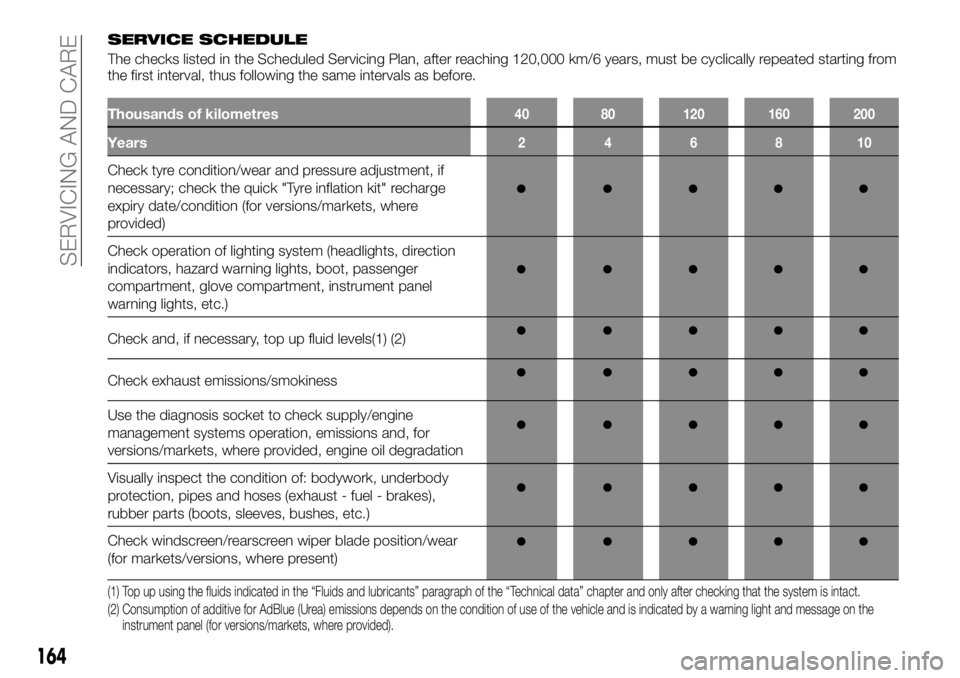
SERVICE SCHEDULE
The checks listed in the Scheduled Servicing Plan, after reaching 120,000 km/6 years, must be cyclically repeated starting from
the first interval, thus following the same intervals as before.
Thousands of kilometres40 80 120 160 200
Years246810
Check tyre condition/wear and pressure adjustment, if
necessary; check the quick "Tyre inflation kit" recharge
expiry date/condition (for versions/markets, where
provided)
Check operation of lighting system (headlights, direction
indicators, hazard warning lights, boot, passenger
compartment, glove compartment, instrument panel
warning lights, etc.)
Check and, if necessary, top up fluid levels(1) (2)
Check exhaust emissions/smokiness
Use the diagnosis socket to check supply/engine
management systems operation, emissions and, for
versions/markets, where provided, engine oil degradation
Visually inspect the condition of: bodywork, underbody
protection, pipes and hoses (exhaust - fuel - brakes),
rubber parts (boots, sleeves, bushes, etc.)
Check windscreen/rearscreen wiper blade position/wear
(for markets/versions, where present)
(1) Top up using the fluids indicated in the “Fluids and lubricants” paragraph of the “Technical data” chapter and only after checking that the system is intact.
(2) Consumption of additive for AdBlue (Urea) emissions depends on the condition of use of the vehicle and is indicated by a warning light and message onthe
instrument panel (for versions/markets, where provided).
164
SERVICING AND CARE
Page 167 of 236
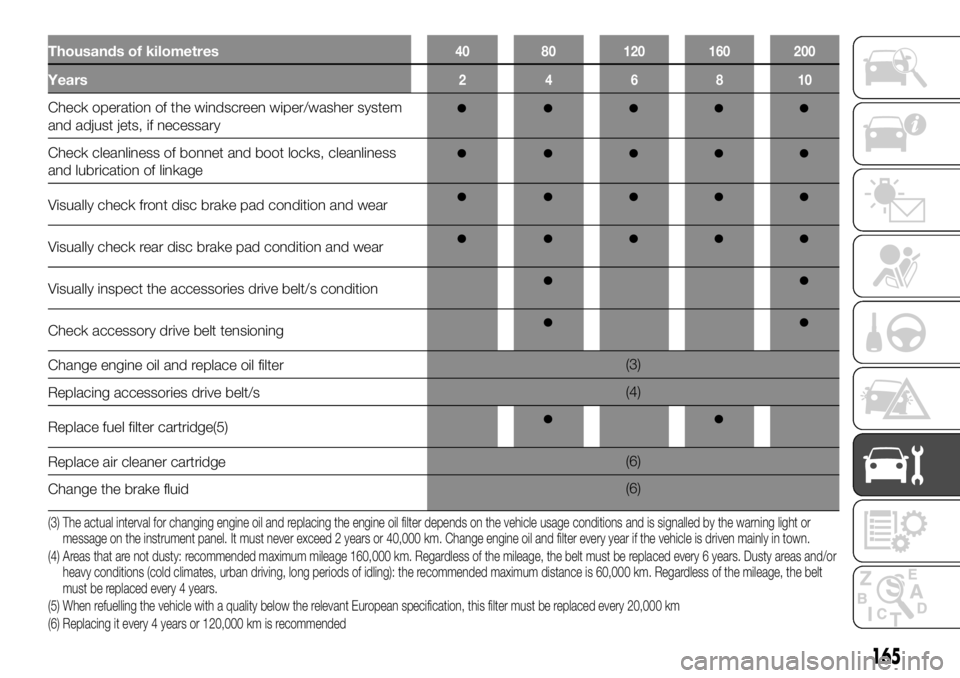
Thousands of kilometres40 80 120 160 200
Years246810
Check operation of the windscreen wiper/washer system
and adjust jets, if necessary
Check cleanliness of bonnet and boot locks, cleanliness
and lubrication of linkage
Visually check front disc brake pad condition and wear
Visually check rear disc brake pad condition and wear
Visually inspect the accessories drive belt/s condition
Check accessory drive belt tensioning
Change engine oil and replace oil filter(3)
Replacing accessories drive belt/s(4)
Replace fuel filter cartridge(5)
Replace air cleaner cartridge(6)
Change the brake fluid(6)
(3) The actual interval for changing engine oil and replacing the engine oil filter depends on the vehicle usage conditions and is signalled by the warning light or
message on the instrument panel. It must never exceed 2 years or 40,000 km. Change engine oil and filter every year if the vehicle is driven mainly in town.
(4) Areas that are not dusty: recommended maximum mileage 160,000 km. Regardless of the mileage, the belt must be replaced every 6 years. Dusty areas and/or
heavy conditions (cold climates, urban driving, long periods of idling): the recommended maximum distance is 60,000 km. Regardless of the mileage, the belt
must be replaced every 4 years.
(5) When refuelling the vehicle with a quality below the relevant European specification, this filter must be replaced every 20,000 km
(6) Replacing it every 4 years or 120,000 km is recommended
165
Page 170 of 236
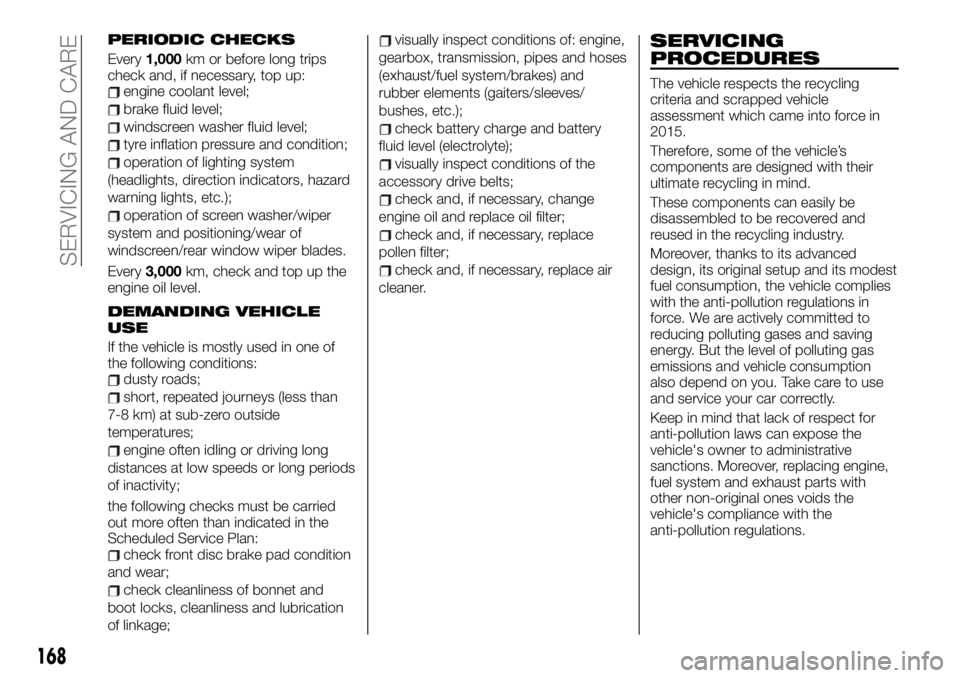
PERIODIC CHECKS
Every1,000km or before long trips
check and, if necessary, top up:
engine coolant level;
brake fluid level;
windscreen washer fluid level;
tyre inflation pressure and condition;
operation of lighting system
(headlights, direction indicators, hazard
warning lights, etc.);
operation of screen washer/wiper
system and positioning/wear of
windscreen/rear window wiper blades.
Every3,000km, check and top up the
engine oil level.
DEMANDING VEHICLE
USE
If the vehicle is mostly used in one of
the following conditions:
dusty roads;
short, repeated journeys (less than
7-8 km) at sub-zero outside
temperatures;
engine often idling or driving long
distances at low speeds or long periods
of inactivity;
the following checks must be carried
out more often than indicated in the
Scheduled Service Plan:
check front disc brake pad condition
and wear;
check cleanliness of bonnet and
boot locks, cleanliness and lubrication
of linkage;
visually inspect conditions of: engine,
gearbox, transmission, pipes and hoses
(exhaust/fuel system/brakes) and
rubber elements (gaiters/sleeves/
bushes, etc.);
check battery charge and battery
fluid level (electrolyte);
visually inspect conditions of the
accessory drive belts;
check and, if necessary, change
engine oil and replace oil filter;
check and, if necessary, replace
pollen filter;
check and, if necessary, replace air
cleaner.
SERVICING
PROCEDURES
The vehicle respects the recycling
criteria and scrapped vehicle
assessment which came into force in
2015.
Therefore, some of the vehicle’s
components are designed with their
ultimate recycling in mind.
These components can easily be
disassembled to be recovered and
reused in the recycling industry.
Moreover, thanks to its advanced
design, its original setup and its modest
fuel consumption, the vehicle complies
with the anti-pollution regulations in
force. We are actively committed to
reducing polluting gases and saving
energy. But the level of polluting gas
emissions and vehicle consumption
also depend on you. Take care to use
and service your car correctly.
Keep in mind that lack of respect for
anti-pollution laws can expose the
vehicle's owner to administrative
sanctions. Moreover, replacing engine,
fuel system and exhaust parts with
other non-original ones voids the
vehicle's compliance with the
anti-pollution regulations.
168
SERVICING AND CARE
Page 171 of 236
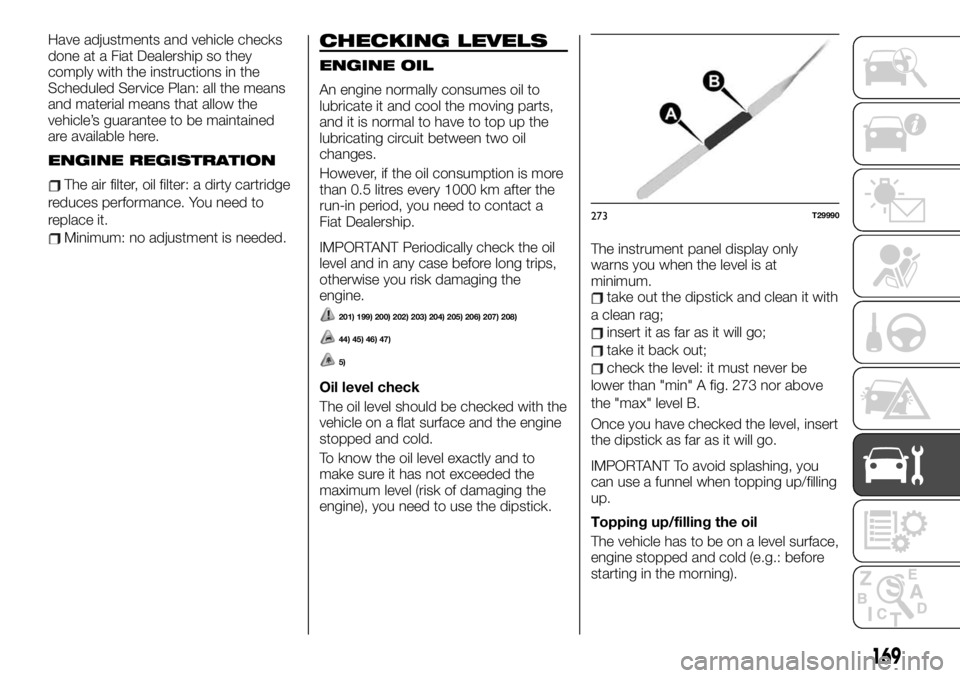
Have adjustments and vehicle checks
done at a Fiat Dealership so they
comply with the instructions in the
Scheduled Service Plan: all the means
and material means that allow the
vehicle’s guarantee to be maintained
are available here.
ENGINE REGISTRATION
The air filter, oil filter: a dirty cartridge
reduces performance. You need to
replace it.
Minimum: no adjustment is needed.
CHECKING LEVELS
ENGINE OIL
An engine normally consumes oil to
lubricate it and cool the moving parts,
and it is normal to have to top up the
lubricating circuit between two oil
changes.
However, if the oil consumption is more
than 0.5 litres every 1000 km after the
run-in period, you need to contact a
Fiat Dealership.
IMPORTANT Periodically check the oil
level and in any case before long trips,
otherwise you risk damaging the
engine.
201) 199) 200) 202) 203) 204) 205) 206) 207) 208)
44) 45) 46) 47)
5)
Oil level check
The oil level should be checked with the
vehicle on a flat surface and the engine
stopped and cold.
To know the oil level exactly and to
make sure it has not exceeded the
maximum level (risk of damaging the
engine), you need to use the dipstick.The instrument panel display only
warns you when the level is at
minimum.
take out the dipstick and clean it with
a clean rag;
insert it as far as it will go;
take it back out;
check the level: it must never be
lower than "min" A fig. 273 nor above
the "max" level B.
Once you have checked the level, insert
the dipstick as far as it will go.
IMPORTANT To avoid splashing, you
can use a funnel when topping up/filling
up.
Topping up/filling the oil
The vehicle has to be on a level surface,
engine stopped and cold (e.g.: before
starting in the morning).
273T29990
169
Page 172 of 236
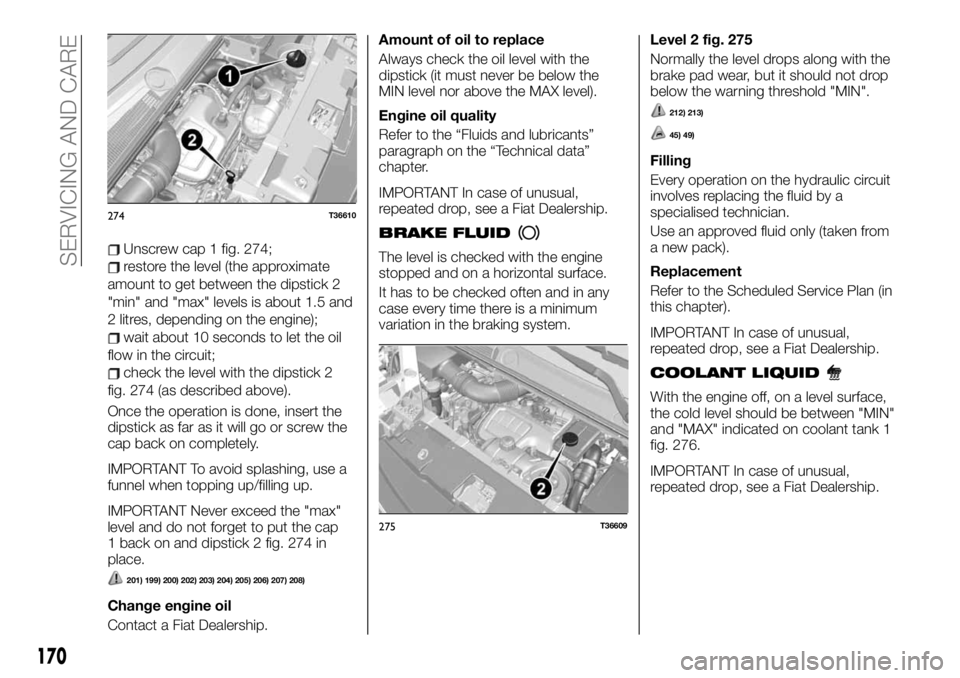
Unscrew cap 1 fig. 274;
restore the level (the approximate
amount to get between the dipstick 2
"min" and "max" levels is about 1.5 and
2 litres, depending on the engine);
wait about 10 seconds to let the oil
flow in the circuit;
check the level with the dipstick 2
fig. 274 (as described above).
Once the operation is done, insert the
dipstick as far as it will go or screw the
cap back on completely.
IMPORTANT To avoid splashing, use a
funnel when topping up/filling up.
IMPORTANT Never exceed the "max"
level and do not forget to put the cap
1 back on and dipstick 2 fig. 274 in
place.
201) 199) 200) 202) 203) 204) 205) 206) 207) 208)
Change engine oil
Contact a Fiat Dealership.Amount of oil to replace
Always check the oil level with the
dipstick (it must never be below the
MIN level nor above the MAX level).
Engine oil quality
Refer to the “Fluids and lubricants”
paragraph on the “Technical data”
chapter.
IMPORTANT In case of unusual,
repeated drop, see a Fiat Dealership.
BRAKE FLUID
The level is checked with the engine
stopped and on a horizontal surface.
It has to be checked often and in any
case every time there is a minimum
variation in the braking system.Level 2 fig. 275
Normally the level drops along with the
brake pad wear, but it should not drop
below the warning threshold "MIN".
212) 213)
45) 49)
Filling
Every operation on the hydraulic circuit
involves replacing the fluid by a
specialised technician.
Use an approved fluid only (taken from
a new pack).
Replacement
Refer to the Scheduled Service Plan (in
this chapter).
IMPORTANT In case of unusual,
repeated drop, see a Fiat Dealership.
COOLANT LIQUID
With the engine off, on a level surface,
the cold level should be between "MIN"
and "MAX" indicated on coolant tank 1
fig. 276.
IMPORTANT In case of unusual,
repeated drop, see a Fiat Dealership.
274T36610
275T36609
170
SERVICING AND CARE
Page 173 of 236
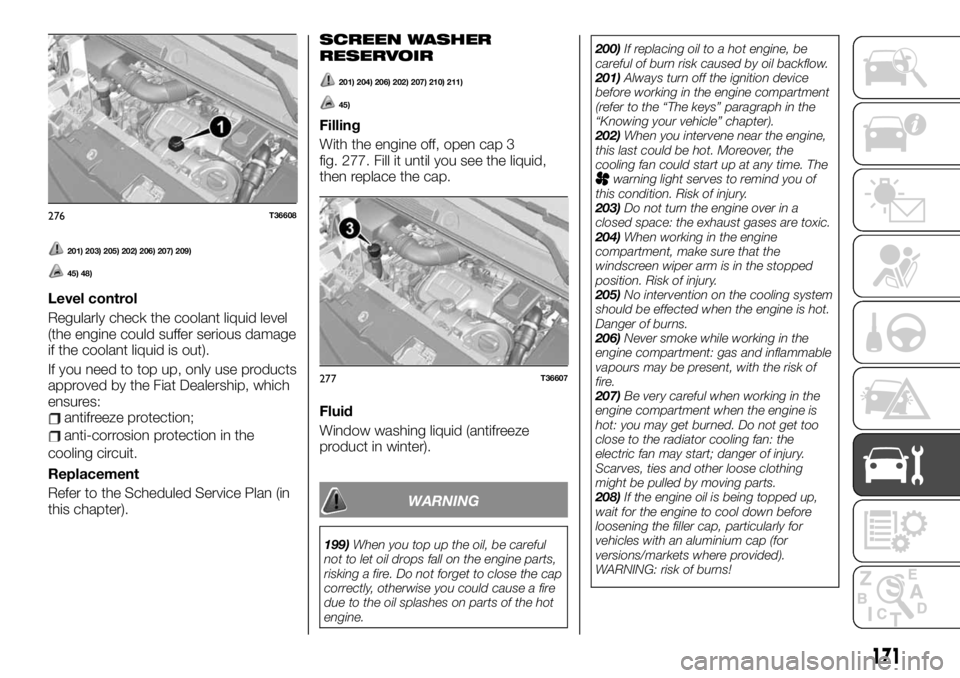
201) 203) 205) 202) 206) 207) 209)
45) 48)
Level control
Regularly check the coolant liquid level
(the engine could suffer serious damage
if the coolant liquid is out).
If you need to top up, only use products
approved by the Fiat Dealership, which
ensures:
antifreeze protection;
anti-corrosion protection in the
cooling circuit.
Replacement
Refer to the Scheduled Service Plan (in
this chapter).
SCREEN WASHER
RESERVOIR
201) 204) 206) 202) 207) 210) 211)
45)
Filling
With the engine off, open cap 3
fig. 277. Fill it until you see the liquid,
then replace the cap.
Fluid
Window washing liquid (antifreeze
product in winter).
WARNING
199)When you top up the oil, be careful
not to let oil drops fall on the engine parts,
risking a fire. Do not forget to close the cap
correctly, otherwise you could cause a fire
due to the oil splashes on parts of the hot
engine.200)If replacing oil to a hot engine, be
careful of burn risk caused by oil backflow.
201)Always turn off the ignition device
before working in the engine compartment
(refer to the “The keys” paragraph in the
“Knowing your vehicle” chapter).
202)When you intervene near the engine,
this last could be hot. Moreover, the
cooling fan could start up at any time. The
warning light serves to remind you of
this condition. Risk of injury.
203)Do not turn the engine over in a
closed space: the exhaust gases are toxic.
204)When working in the engine
compartment, make sure that the
windscreen wiper arm is in the stopped
position. Risk of injury.
205)No intervention on the cooling system
should be effected when the engine is hot.
Danger of burns.
206)Never smoke while working in the
engine compartment: gas and inflammable
vapours may be present, with the risk of
fire.
207)Be very careful when working in the
engine compartment when the engine is
hot: you may get burned. Do not get too
close to the radiator cooling fan: the
electric fan may start; danger of injury.
Scarves, ties and other loose clothing
might be pulled by moving parts.
208)If the engine oil is being topped up,
wait for the engine to cool down before
loosening the filler cap, particularly for
vehicles with an aluminium cap (for
versions/markets where provided).
WARNING: risk of burns!
276T36608
277T36607
171
Page 180 of 236
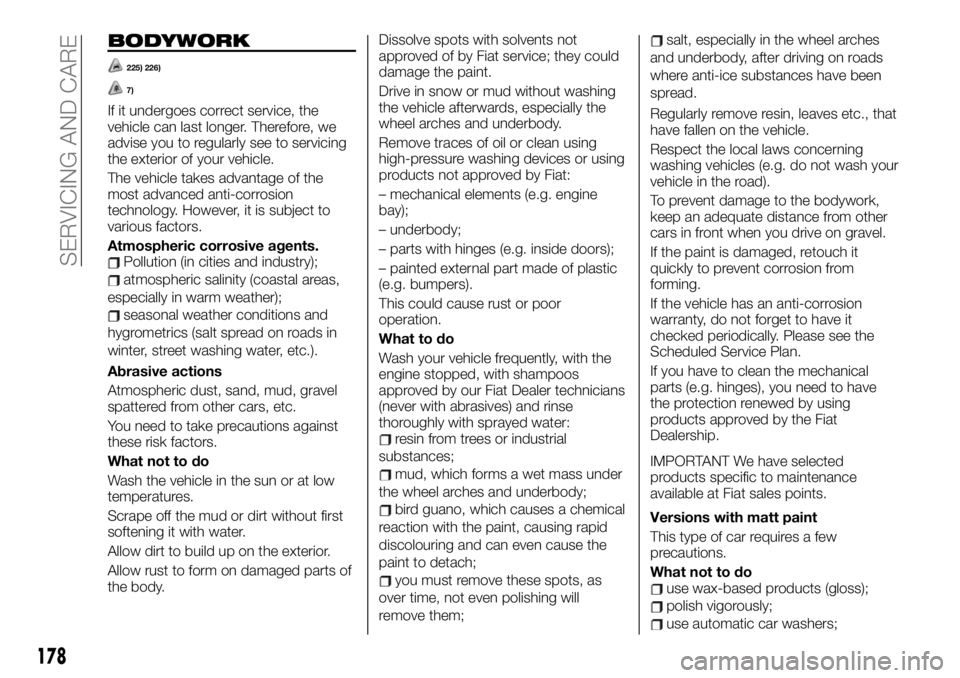
BODYWORK
225) 226)
7)
If it undergoes correct service, the
vehicle can last longer. Therefore, we
advise you to regularly see to servicing
the exterior of your vehicle.
The vehicle takes advantage of the
most advanced anti-corrosion
technology. However, it is subject to
various factors.
Atmospheric corrosive agents.
Pollution (in cities and industry);
atmospheric salinity (coastal areas,
especially in warm weather);
seasonal weather conditions and
hygrometrics (salt spread on roads in
winter, street washing water, etc.).
Abrasive actions
Atmospheric dust, sand, mud, gravel
spattered from other cars, etc.
You need to take precautions against
these risk factors.
What not to do
Wash the vehicle in the sun or at low
temperatures.
Scrape off the mud or dirt without first
softening it with water.
Allow dirt to build up on the exterior.
Allow rust to form on damaged parts of
the body.Dissolve spots with solvents not
approved of by Fiat service; they could
damage the paint.
Drive in snow or mud without washing
the vehicle afterwards, especially the
wheel arches and underbody.
Remove traces of oil or clean using
high-pressure washing devices or using
products not approved by Fiat:
– mechanical elements (e.g. engine
bay);
– underbody;
– parts with hinges (e.g. inside doors);
– painted external part made of plastic
(e.g. bumpers).
This could cause rust or poor
operation.
What to do
Wash your vehicle frequently, with the
engine stopped, with shampoos
approved by our Fiat Dealer technicians
(never with abrasives) and rinse
thoroughly with sprayed water:
resin from trees or industrial
substances;
mud, which forms a wet mass under
the wheel arches and underbody;
bird guano, which causes a chemical
reaction with the paint, causing rapid
discolouring and can even cause the
paint to detach;
you must remove these spots, as
over time, not even polishing will
remove them;
salt, especially in the wheel arches
and underbody, after driving on roads
where anti-ice substances have been
spread.
Regularly remove resin, leaves etc., that
have fallen on the vehicle.
Respect the local laws concerning
washing vehicles (e.g. do not wash your
vehicle in the road).
To prevent damage to the bodywork,
keep an adequate distance from other
cars in front when you drive on gravel.
If the paint is damaged, retouch it
quickly to prevent corrosion from
forming.
If the vehicle has an anti-corrosion
warranty, do not forget to have it
checked periodically. Please see the
Scheduled Service Plan.
If you have to clean the mechanical
parts (e.g. hinges), you need to have
the protection renewed by using
products approved by the Fiat
Dealership.
IMPORTANT We have selected
products specific to maintenance
available at Fiat sales points.
Versions with matt paint
This type of car requires a few
precautions.
What not to do
use wax-based products (gloss);
polish vigorously;
use automatic car washers;
178
SERVICING AND CARE
Page 225 of 236
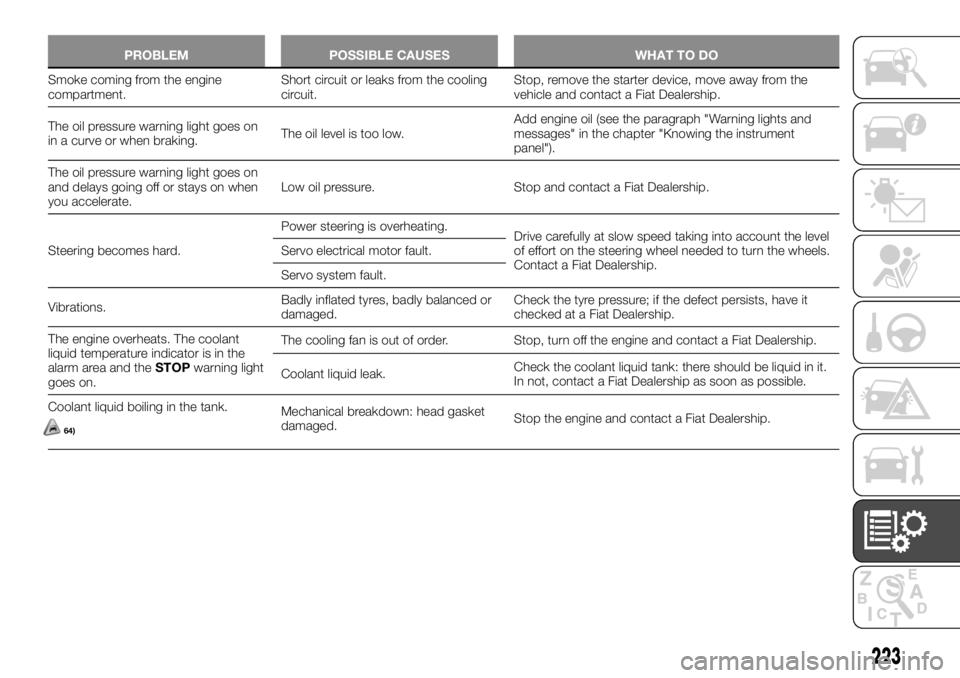
PROBLEM POSSIBLE CAUSES WHAT TO DO
Smoke coming from the engine
compartment.Short circuit or leaks from the cooling
circuit.Stop, remove the starter device, move away from the
vehicle and contact a Fiat Dealership.
The oil pressure warning light goes on
in a curve or when braking.The oil level is too low.Add engine oil (see the paragraph "Warning lights and
messages" in the chapter "Knowing the instrument
panel").
The oil pressure warning light goes on
and delays going off or stays on when
you accelerate.Low oil pressure. Stop and contact a Fiat Dealership.
Steering becomes hard.Power steering is overheating.
Drive carefully at slow speed taking into account the level
of effort on the steering wheel needed to turn the wheels.
Contact a Fiat Dealership. Servo electrical motor fault.
Servo system fault.
Vibrations.Badly inflated tyres, badly balanced or
damaged.Check the tyre pressure; if the defect persists, have it
checked at a Fiat Dealership.
The engine overheats. The coolant
liquid temperature indicator is in the
alarm area and theSTOPwarning light
goes on.The cooling fan is out of order. Stop, turn off the engine and contact a Fiat Dealership.
Coolant liquid leak.Check the coolant liquid tank: there should be liquid in it.
In not, contact a Fiat Dealership as soon as possible.
Coolant liquid boiling in the tank.
64)
Mechanical breakdown: head gasket
damaged.Stop the engine and contact a Fiat Dealership.
223